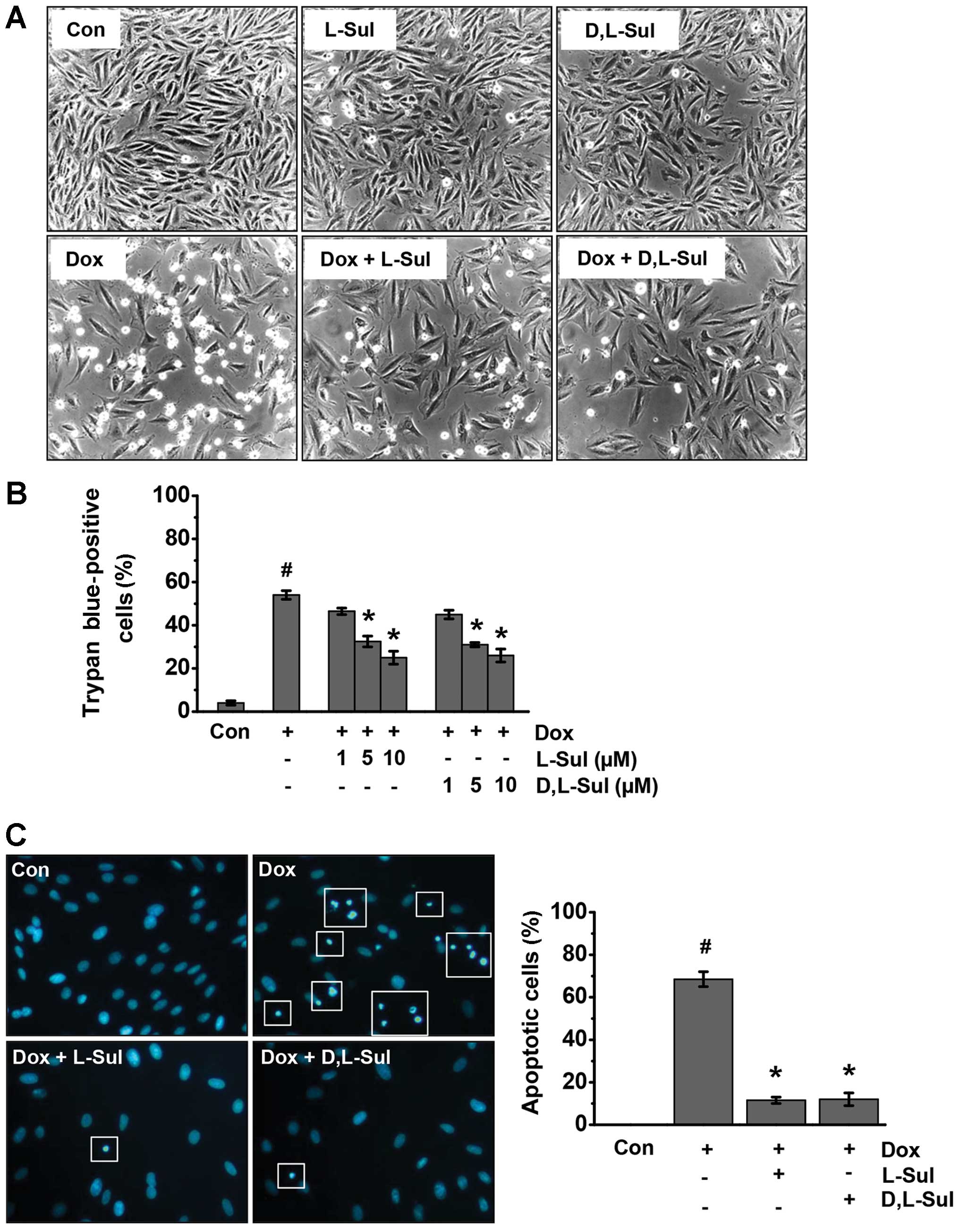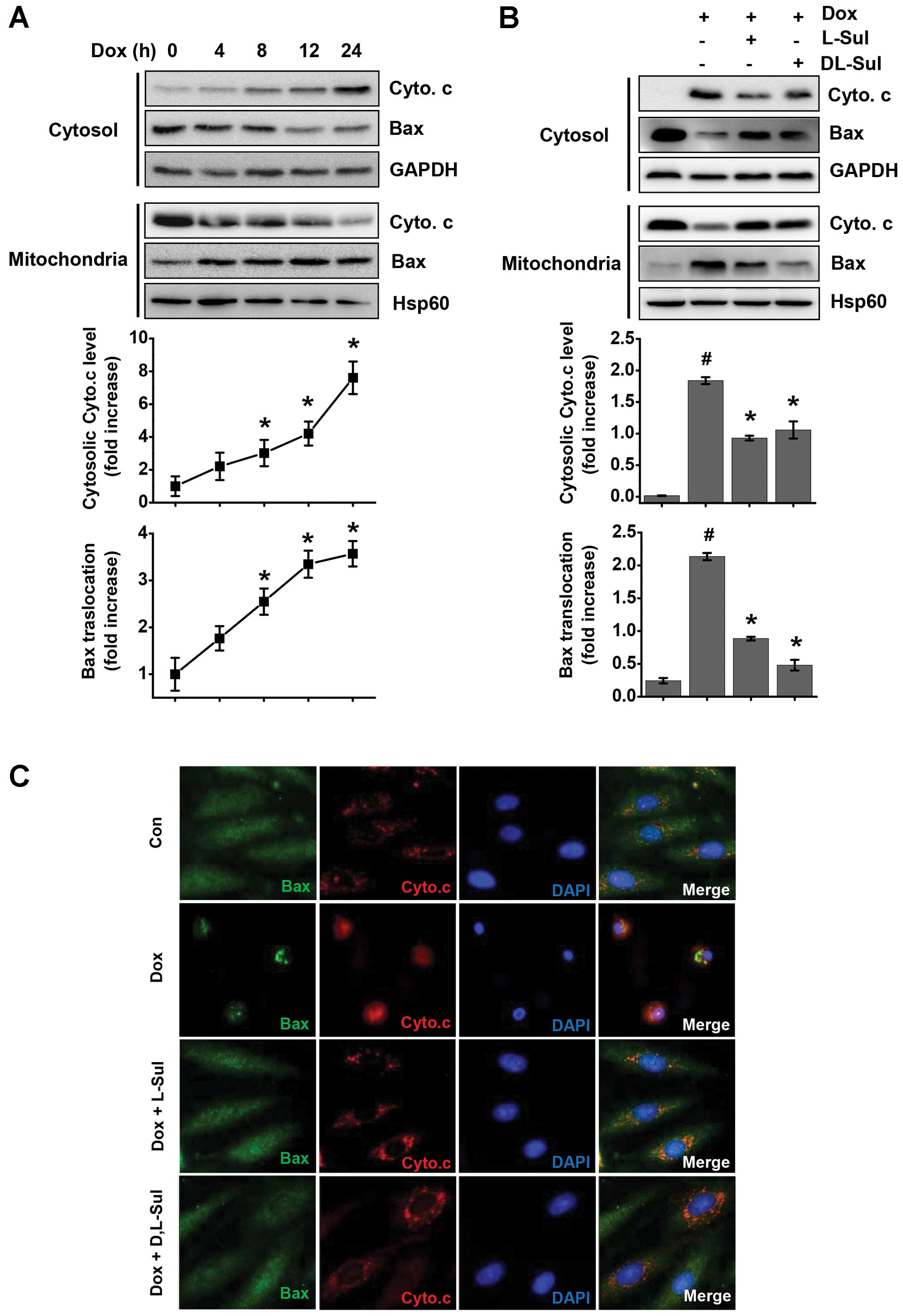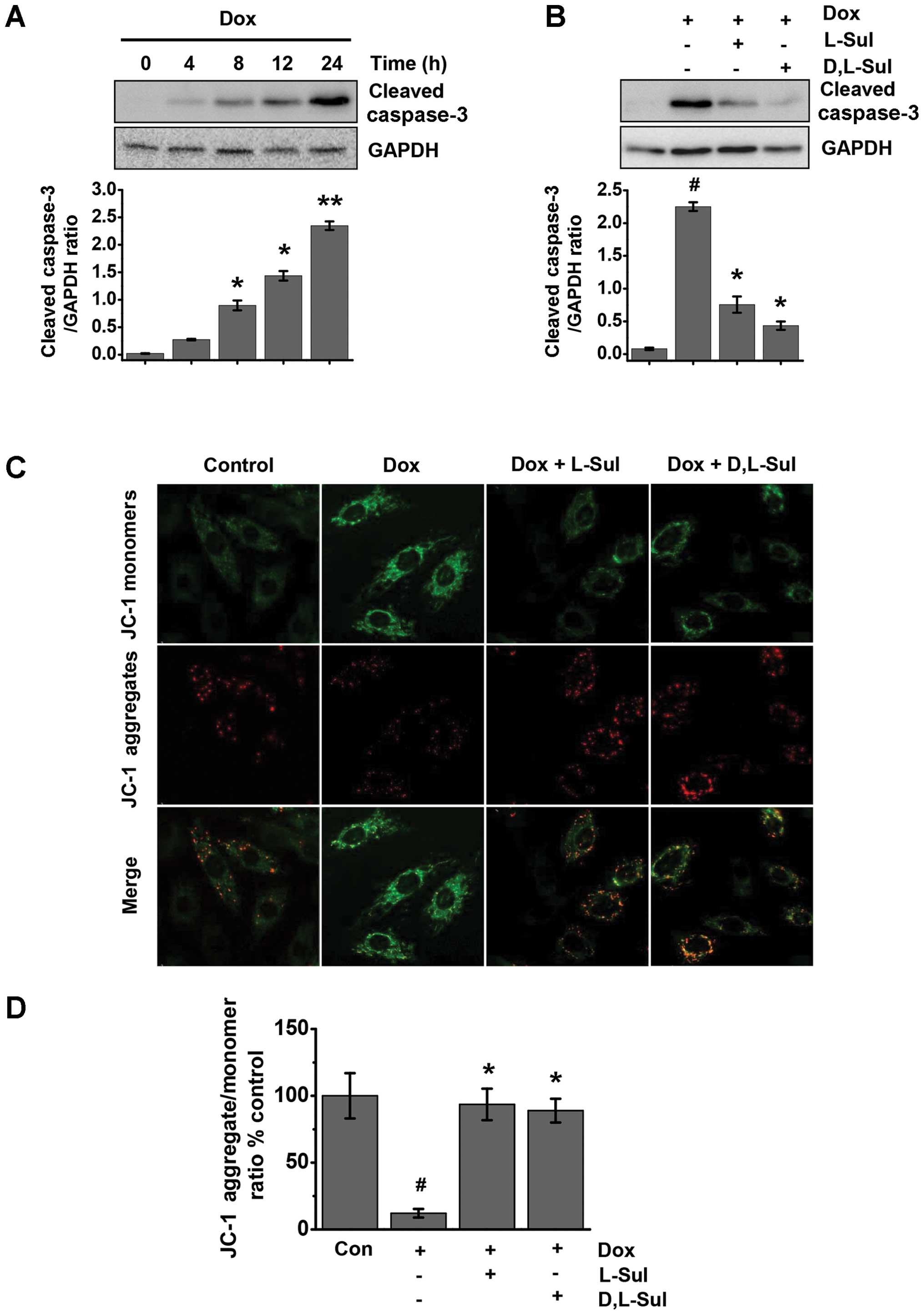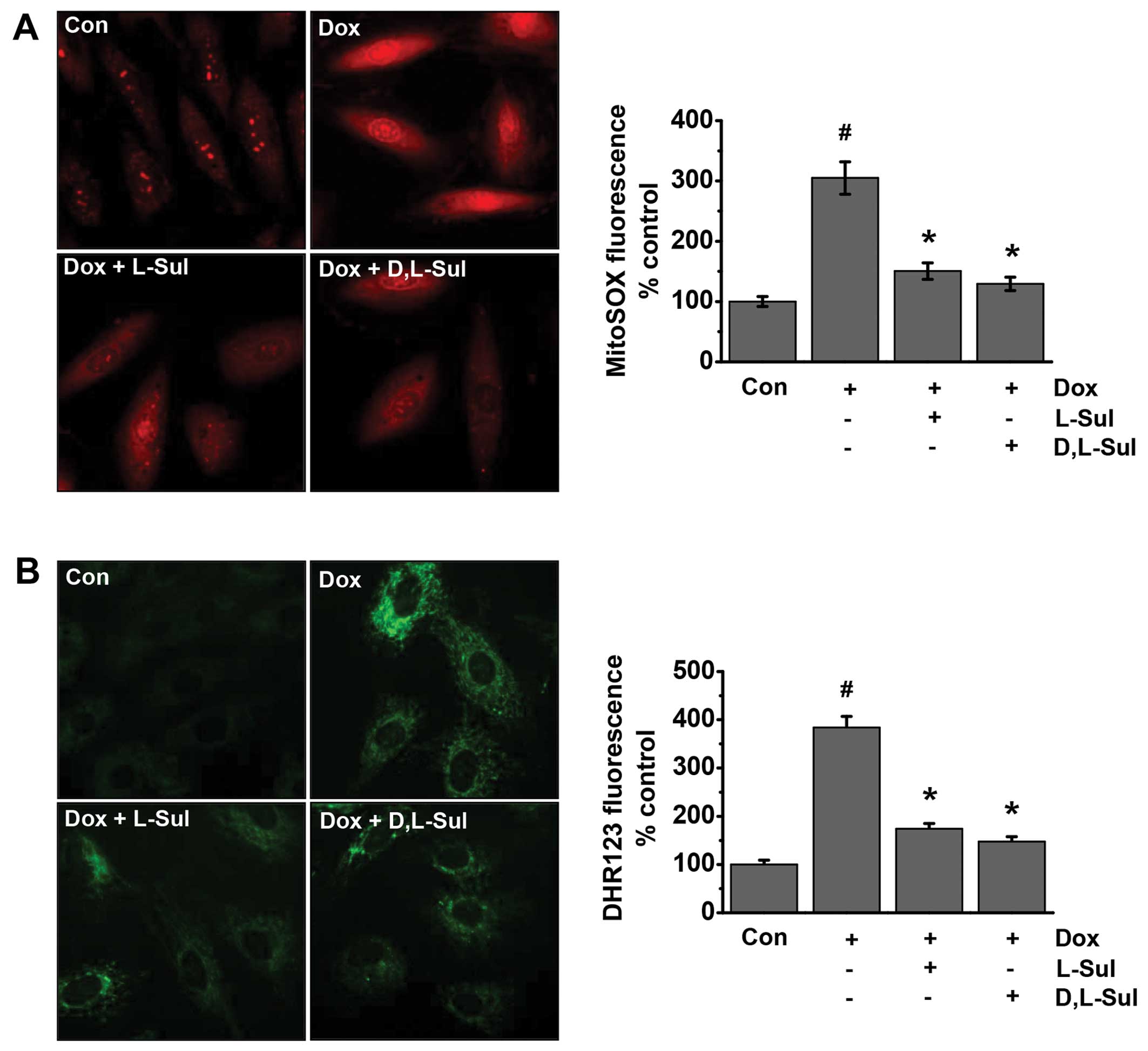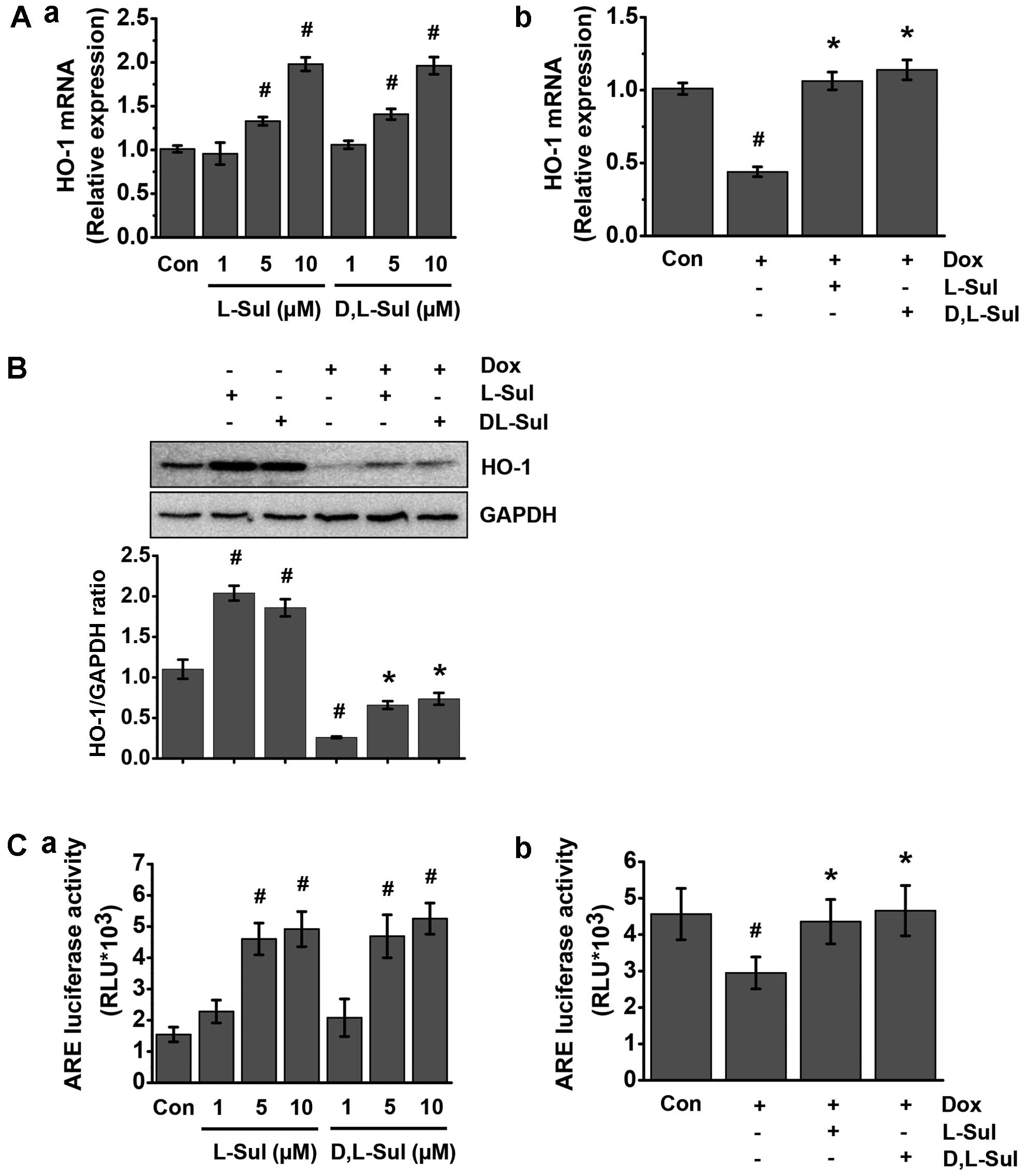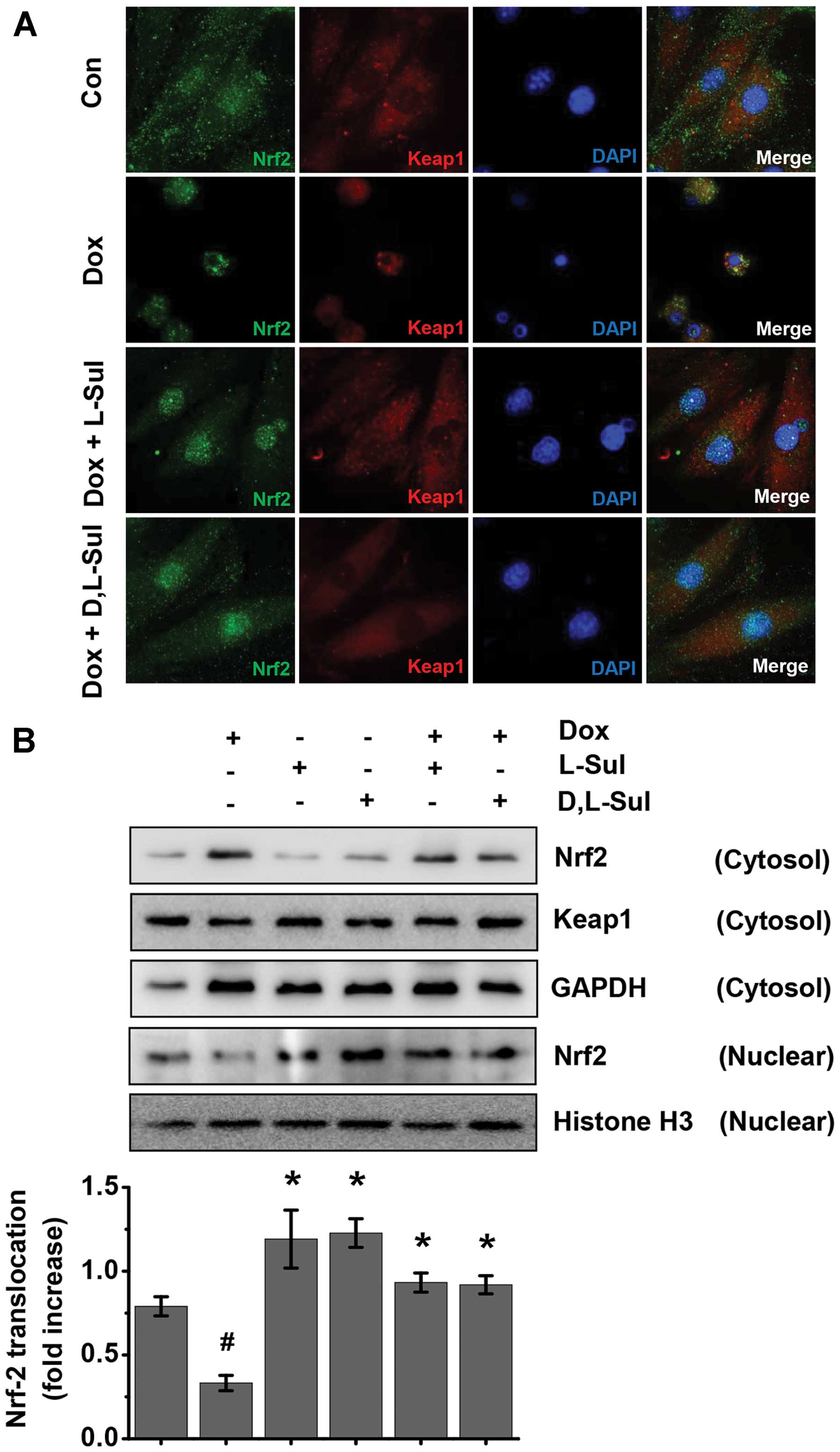|
1
|
Vilaseca J, Guardia J, Bacardi R and Monné
J: Doxorubicin for liver cancer. Lancet. 1:13671978. View Article : Google Scholar : PubMed/NCBI
|
|
2
|
Arcamone F, Cassinelli G, Fantini G, Grein
A, Orezzi P, Pol C and Spalla C: Adriamycin, 14-hydroxydaunomycin,
a new antitumor antibiotic from S. peucetius var. caesius.
Biotechnol Bioeng. 11:1101–1110. 1969. View Article : Google Scholar : PubMed/NCBI
|
|
3
|
Hortobágyi GN: Anthracyclines in the
treatment of cancer. An overview. Drugs. 54(Suppl 4): S1–S7.
1997.
|
|
4
|
Gewirtz DA: A critical evaluation of the
mechanisms of action proposed for the antitumor effects of the
anthracycline antibiotics adriamycin and daunorubicin. Biochem
Pharmacol. 57:727–741. 1999. View Article : Google Scholar : PubMed/NCBI
|
|
5
|
Muggia FM: Clinical efficacy and prospects
for use of pegylated liposomal doxorubicin in the treatment of
ovarian and breast cancers. Drugs. 54(Suppl 4): S22–S29. 1997.
View Article : Google Scholar
|
|
6
|
Naito S, Kotoh S, Omoto T, Osada Y,
Sagiyama K, Iguchi A, Ariyoshi A, Hiratsuka Y and Kumazawa J; The
Kyushu University Urological Oncology Group: Prophylactic
intravesical instillation chemotherapy against recurrence after a
transurethral resection of superficial bladder cancer: A randomized
controlled trial of doxorubicin plus verapamil versus doxorubicin
alone. Cancer Chemother Pharmacol. 42:367–372. 1998. View Article : Google Scholar
|
|
7
|
Mukhopadhyay P, Rajesh M, Bátkai S,
Kashiwaya Y, Haskó G, Liaudet L, Szabó C and Pacher P: Role of
superoxide, nitric oxide, and peroxynitrite in doxorubicin-induced
cell death in vivo and in vitro. Am J Physiol Heart Circ Physiol.
296:H1466–H1483. 2009. View Article : Google Scholar : PubMed/NCBI
|
|
8
|
Childs AC, Phaneuf SL, Dirks AJ, Phillips
T and Leeuwenburgh C: Doxorubicin treatment in vivo causes
cytochrome c release and cardiomyocyte apoptosis, as well as
increased mitochondrial efficiency, superoxide dismutase activity,
and Bcl-2:Bax ratio. Cancer Res. 62:4592–4598. 2002.PubMed/NCBI
|
|
9
|
Tatlidede E, Sehirli O, Velioğlu-Oğünc A,
Cetinel S, Yeğen BC, Yarat A, Süleymanoğlu S and Sener G:
Resveratrol treatment protects against doxorubicin-induced
cardiotoxicity by alleviating oxidative damage. Free Radic Res.
43:195–205. 2009. View Article : Google Scholar : PubMed/NCBI
|
|
10
|
Wang XL, Wang X, Xiong LL, Zhu Y, Chen HL,
Chen JX, Wang XX, Li RL, Guo ZY, Li P and Jiang W: Salidroside
improves doxorubicin-induced cardiac dysfunction by suppression of
excessive oxidative stress and cardiomyocyte apoptosis. J
Cardiovasc Pharmacol. 62:512–523. 2013. View Article : Google Scholar : PubMed/NCBI
|
|
11
|
Kim DS, Woo ER, Chae SW, Ha KC, Lee GH,
Hong ST, Kwon DY, Kim MS, Jung YK, Kim HM, et al: Plantainoside D
protects adriamycin-induced apoptosis in H9c2 cardiac muscle cells
via the inhibition of ROS generation and NF-kappaB activation. Life
Sci. 80:314–323. 2007. View Article : Google Scholar
|
|
12
|
Zhang Y, Talalay P, Cho CG and Posner GH:
A major inducer of anticarcinogenic protective enzymes from
broccoli: Isolation and elucidation of structure. Proc Natl Acad
Sci USA. 89:2399–2403. 1992. View Article : Google Scholar : PubMed/NCBI
|
|
13
|
Sakao K and Singh SV:
D,L-sulforaphane-induced apoptosis in human breast cancer cells is
regulated by the adapter protein p66Shc. J Cell Biochem.
113:599–610. 2012. View Article : Google Scholar :
|
|
14
|
Nestle M: Broccoli sprouts as inducers of
carcinogen-detoxifying enzyme systems: Clinical, dietary, and
policy implications. Proc Natl Acad Sci USA. 94:11149–11151. 1997.
View Article : Google Scholar : PubMed/NCBI
|
|
15
|
Tanito M, Masutani H, Kim YC, Nishikawa M,
Ohira A and Yodoi J: Sulforaphane induces thioredoxin through the
antioxidant-responsive element and attenuates retinal light damage
in mice. Invest Ophthalmol Vis Sci. 46:979–987. 2005. View Article : Google Scholar : PubMed/NCBI
|
|
16
|
Surh YJ: Cancer chemoprevention with
dietary phytochemicals. Nat Rev Cancer. 3:768–780. 2003. View Article : Google Scholar : PubMed/NCBI
|
|
17
|
Yoon HY, Kang NI, Lee HK, Jang KY, Park JW
and Park BH: Sulforaphane protects kidneys against
ischemia-reperfusion injury through induction of the Nrf2-dependent
phase 2 enzyme. Biochem Pharmacol. 75:2214–2223. 2008. View Article : Google Scholar : PubMed/NCBI
|
|
18
|
Zhao J, Kobori N, Aronowski J and Dash PK:
Sulforaphane reduces infarct volume following focal cerebral
ischemia in rodents. Neurosci Lett. 393:108–112. 2006. View Article : Google Scholar
|
|
19
|
Satoh T, Okamoto SI, Cui J, Watanabe Y,
Furuta K, Suzuki M, Tohyama K and Lipton SA: Activation of the
Keap1/Nrf2 pathway for neuroprotection by electrophilic [correction
of electrophillic] phase II inducers. Proc Natl Acad Sci USA.
103:768–773. 2006. View Article : Google Scholar
|
|
20
|
Barbagallo I, Galvano F, Frigiola A,
Cappello F, Riccioni G, Murabito P, D’Orazio N, Torella M, Gazzolo
D and Li Volti G: Potential therapeutic effects of natural heme
oxygenase-1 inducers in cardiovascular diseases. Antioxid Redox
Signal. 18:507–521. 2013. View Article : Google Scholar
|
|
21
|
Jazwa A and Cuadrado A: Targeting heme
oxygenase-1 for neuroprotection and neuroinflammation in
neurodegenerative diseases. Curr Drug Targets. 11:1517–1531. 2010.
View Article : Google Scholar : PubMed/NCBI
|
|
22
|
Wang RQ, Nan YM, Wu WJ, Kong LB, Han F,
Zhao SX, Kong L and Yu J: Induction of heme oxygenase-1 protects
against nutritional fibrosing steatohepatitis in mice. Lipids
Health Dis. 10:312011. View Article : Google Scholar : PubMed/NCBI
|
|
23
|
Angeloni C, Leoncini E, Malaguti M,
Angelini S, Hrelia P and Hrelia S: Modulation of phase II enzymes
by sulforaphane: Implications for its cardioprotective potential. J
Agric Food Chem. 57:5615–5622. 2009. View Article : Google Scholar : PubMed/NCBI
|
|
24
|
Piao CS, Gao S, Lee GH, Kim S, Park BH,
Chae SW, Chae HJ and Kim SH: Sulforaphane protects ischemic injury
of hearts through antioxidant pathway and mitochondrial K(ATP)
channels. Pharmacol Res. 61:342–348. 2010. View Article : Google Scholar
|
|
25
|
Strober W: Trypan blue exclusion test of
cell viability. Curr Protoc Immunol Appendix 3. Appendix 3B. 2001.
View Article : Google Scholar
|
|
26
|
Latt SA and Wohlleb JC: Optical studies of
the interaction of 33258 Hoechst with DNA, chromatin, and metaphase
chromosomes. Chromosoma. 52:297–316. 1975. View Article : Google Scholar : PubMed/NCBI
|
|
27
|
Chae HJ, Kim HR, Xu C, Bailly-Maitre B,
Krajewska M, Krajewski S, Banares S, Cui J, Digicaylioglu M, Ke N,
et al: BI-1 regulates an apoptosis pathway linked to endoplasmic
reticulum stress. Mol Cell. 15:355–366. 2004. View Article : Google Scholar : PubMed/NCBI
|
|
28
|
Ludke AR, Sharma AK, Akolkar G, Bajpai G
and Singal PK: Downregulation of vitamin C transporter SVCT-2 in
doxorubicin-induced cardiomyocyte injury. Am J Physiol Cell
Physiol. 303:C645–C653. 2012. View Article : Google Scholar : PubMed/NCBI
|
|
29
|
Jiang M, Wang CY, Huang S, Yang T and Dong
Z: Cisplatin-induced apoptosis in p53-deficient renal cells via the
intrinsic mitochondrial pathway. Am J Physiol Renal Physiol.
296:F983–F993. 2009. View Article : Google Scholar : PubMed/NCBI
|
|
30
|
Salvioli S, Ardizzoni A, Franceschi C and
Cossarizza A: JC-1, but not DiOC6(3) or rhodamine 123, is a
reliable fluorescent probe to assess delta psi changes in intact
cells: Implications for studies on mitochondrial functionality
during apoptosis. FEBS Lett. 411:77–82. 1997. View Article : Google Scholar : PubMed/NCBI
|
|
31
|
Kooy NW, Royall JA, Ischiropoulos H and
Beckman JS: Peroxynitrite-mediated oxidation of dihydrorhodamine
123. Free Radic Biol Med. 16:149–156. 1994. View Article : Google Scholar : PubMed/NCBI
|
|
32
|
Tarpey MM and Fridovich I: Methods of
detection of vascular reactive species: Nitric oxide, superoxide,
hydrogen peroxide, and peroxynitrite. Circ Res. 89:224–236. 2001.
View Article : Google Scholar : PubMed/NCBI
|
|
33
|
Sobreira C, Davidson M, King MP and
Miranda AF: Dihydrorhodamine 123 identifies impaired mitochondrial
respiratory chain function in cultured cells harboring
mitochondrial DNA mutations. J Histochem Cytochem. 44:571–579.
1996. View Article : Google Scholar : PubMed/NCBI
|
|
34
|
Crow JP: Dichlorodihydrofluorescein and
dihydrorhodamine 123 are sensitive indicators of peroxynitrite in
vitro: Implications for intracellular measurement of reactive
nitrogen and oxygen species. Nitric Oxide. 1:145–157. 1997.
View Article : Google Scholar : PubMed/NCBI
|
|
35
|
Robinson KM, Janes MS and Beckman JS: The
selective detection of mitochondrial superoxide by live cell
imaging. Nat Protoc. 3:941–947. 2008. View Article : Google Scholar : PubMed/NCBI
|
|
36
|
Mukhopadhyay P, Rajesh M, Yoshihiro K,
Haskó G and Pacher P: Simple quantitative detection of
mitochondrial superoxide production in live cells. Biochem Biophys
Res Commun. 358:203–208. 2007. View Article : Google Scholar : PubMed/NCBI
|
|
37
|
Ito T, Okumura H, Tsukue N, Kobayashi T,
Honda K and Sekizawa K: Effect of diesel exhaust particles on mRNA
expression of viral and bacterial receptors in rat lung epithelial
L2 cells. Toxicol Lett. 165:66–70. 2006. View Article : Google Scholar : PubMed/NCBI
|
|
38
|
Ly JD, Grubb DR and Lawen A: The
mitochondrial membrane potential (deltapsi(m)) in apoptosis; an
update. Apoptosis. 8:115–128. 2003. View Article : Google Scholar : PubMed/NCBI
|
|
39
|
Tsang WP, Chau SP, Kong SK, Fung KP and
Kwok TT: Reactive oxygen species mediate doxorubicin induced
p53-independent apoptosis. Life Sci. 73:2047–2058. 2003. View Article : Google Scholar : PubMed/NCBI
|
|
40
|
Sawyer DB, Fukazawa R, Arstall MA and
Kelly RA: Daunorubicin-induced apoptosis in rat cardiac myocytes is
inhibited by dexrazoxane. Circ Res. 84:257–265. 1999. View Article : Google Scholar : PubMed/NCBI
|
|
41
|
Kotamraju S, Konorev EA, Joseph J and
Kalyanaraman B: Doxorubicin-induced apoptosis in endothelial cells
and cardiomyocytes is ameliorated by nitrone spin traps and
ebselen. Role of reactive oxygen and nitrogen species. J Biol Chem.
275:33585–33592. 2000. View Article : Google Scholar : PubMed/NCBI
|
|
42
|
Mihm MJ, Yu F, Weinstein DM, Reiser PJ and
Bauer JA: Intracellular distribution of peroxynitrite during
doxorubicin cardiomyopathy: Evidence for selective impairment of
myofibrillar creatine kinase. Br J Pharmacol. 135:581–588. 2002.
View Article : Google Scholar : PubMed/NCBI
|
|
43
|
Luanpitpong S, Chanvorachote P, Nimmannit
U, Leonard SS, Stehlik C, Wang L and Rojanasakul Y: Mitochondrial
superoxide mediates doxorubicin-induced keratinocyte apoptosis
through oxidative modification of ERK and Bcl-2 ubiquitination.
Biochem Pharmacol. 83:1643–1654. 2012. View Article : Google Scholar : PubMed/NCBI
|
|
44
|
Lee YJ, Jeong HY, Kim YB, Lee YJ, Won SY,
Shim JH, Cho MK, Nam HS and Lee SH: Reactive oxygen species and
PI3K/Akt signaling play key roles in the induction of Nrf2-driven
heme oxygenase-1 expression in sulforaphane-treated human
mesothelioma MSTO-211H cells. Food Chem Toxicol. 50:116–123. 2012.
View Article : Google Scholar
|
|
45
|
Surh YJ, Na HK and Lee SS: Transcription
factors and mitogen-activated protein kinases as molecular targets
for chemoprevention with anti-inflammatory phytochemicals.
Biofactors. 21:103–108. 2004. View Article : Google Scholar
|
|
46
|
Scott JM, Khakoo A, Mackey JR, Haykowsky
MJ, Douglas PS and Jones LW: Modulation of anthracycline-induced
cardiotoxicity by aerobic exercise in breast cancer: Current
evidence and underlying mechanisms. Circulation. 124:642–650. 2011.
View Article : Google Scholar : PubMed/NCBI
|
|
47
|
Kimes BW and Brandt BL: Properties of a
clonal muscle cell line from rat heart. Exp Cell Res. 98:367–381.
1976. View Article : Google Scholar : PubMed/NCBI
|
|
48
|
Watkins SJ, Borthwick GM and Arthur HM:
The H9C2 cell line and primary neonatal cardiomyocyte cells show
similar hypertrophic responses in vitro. In Vitro Cell Dev Biol
Anim. 47:125–131. 2011. View Article : Google Scholar
|
|
49
|
Prathapan A, Vineetha VP, Abhilash PA and
Raghu KG: Boerhaavia diffusa L. attenuates angiotensin II-induced
hypertrophy in H9c2 cardiac myoblast cells via modulating oxidative
stress and down-regulating NF-κB and transforming growth factor β1.
Br J Nutr. 110:1201–1210. 2013. View Article : Google Scholar : PubMed/NCBI
|
|
50
|
Karagiannis TC, Lin AJ, Ververis K, Chang
L, Tang MM, Okabe J and El-Osta A: Trichostatin A accentuates
doxorubicin-induced hypertrophy in cardiac myocytes. Aging (Albany
NY). 2:659–668. 2010.
|
|
51
|
Merten KE, Jiang Y, Feng W and Kang YJ:
Calcineurin activation is not necessary for Doxorubicin-induced
hypertrophy in H9c2 embryonic rat cardiac cells: Involvement of the
phosphoinositide 3-kinase-Akt pathway. J Pharmacol Exp Ther.
319:934–940. 2006. View Article : Google Scholar : PubMed/NCBI
|
|
52
|
Wang GW, Klein JB and Kang YJ:
Metallothionein inhibits doxorubicin-induced mitochondrial
cytochrome c release and caspase-3 activation in cardiomyocytes. J
Pharmacol Exp Ther. 298:461–468. 2001.PubMed/NCBI
|
|
53
|
Hare JM: Oxidative stress and apoptosis in
heart failure progression. Circ Res. 89:198–200. 2001.PubMed/NCBI
|
|
54
|
Gao X and Talalay P: Induction of phase 2
genes by sulforaphane protects retinal pigment epithelial cells
against photooxidative damage. Proc Natl Acad Sci USA.
101:10446–10451. 2004. View Article : Google Scholar : PubMed/NCBI
|
|
55
|
Al-Abd AM, Al-Abbasi FA, Asaad GF and
Abdel-Naim AB: Didox potentiates the cytotoxic profile of
doxorubicin and protects from its cardiotoxicity. Eur J Pharmacol.
718:361–369. 2013. View Article : Google Scholar : PubMed/NCBI
|
|
56
|
Jay SM, Murthy AC, Hawkins JF, Wortzel JR,
Steinhauser ML, Alvarez LM, Gannon J, Macrae CA, Griffith LG and
Lee RT: An engineered bivalent neuregulin protects against
doxorubicin-induced cardiotoxicity with reduced proneoplastic
potential. Circulation. 128:152–161. 2013. View Article : Google Scholar : PubMed/NCBI
|
|
57
|
Osman AM, Al-Harthi SE, AlArabi OM, Elshal
MF, Ramadan WS, Alaama MN, Al-Kreathy HM, Damanhouri ZA and Osman
OH: Chemosensetizing and cardioprotective effects of resveratrol in
doxorubicin-treated animals. Cancer Cell Int. 13:522013. View Article : Google Scholar
|
|
58
|
Ahmed LA and El-Maraghy SA: Nicorandil
ameliorates mitochondrial dysfunction in doxorubicin-induced heart
failure in rats: Possible mechanism of cardioprotection. Biochem
Pharmacol. 86:1301–1310. 2013. View Article : Google Scholar : PubMed/NCBI
|
|
59
|
Choi HJ, Seon MR, Lim SS, Kim JS, Chun HS
and Park JH: Hexane/ethanol extract of Glycyrrhiza uralensis
licorice suppresses doxorubicin-induced apoptosis in H9c2 rat
cardiac myoblasts. Exp Biol Med (Maywood). 233:1554–1560. 2008.
View Article : Google Scholar
|
|
60
|
Fimognari C, Nüsse M, Lenzi M, Sciuscio D,
Cantelli-Forti G and Hrelia P: Sulforaphane increases the efficacy
of doxorubicin in mouse fibroblasts characterized by p53 mutations.
Mutat Res. 601:92–101. 2006. View Article : Google Scholar : PubMed/NCBI
|
|
61
|
Hu L, Miao W, Loignon M, Kandouz M and
Batist G: Putative chemopreventive molecules can increase
Nrf2-regulated cell defense in some human cancer cell lines,
resulting in resistance to common cytotoxic therapies. Cancer
Chemother Pharmacol. 66:467–474. 2010. View Article : Google Scholar
|















